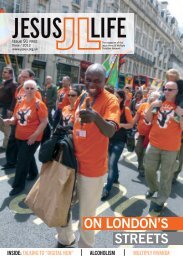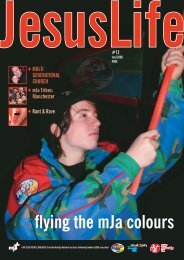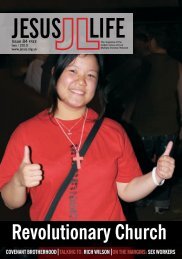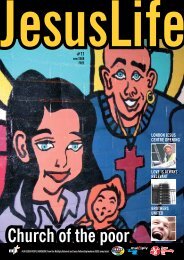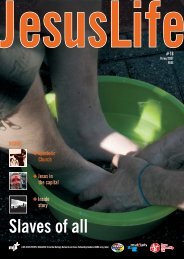Life of William Carey by George Smith - The Jesus Army
Life of William Carey by George Smith - The Jesus Army
Life of William Carey by George Smith - The Jesus Army
You also want an ePaper? Increase the reach of your titles
YUMPU automatically turns print PDFs into web optimized ePapers that Google loves.
weapons, in winning the first victories over the secular as well as spiritual lawlessness which fell before Paul<br />
and his successors down to Augustine and his City <strong>of</strong> God. <strong>The</strong> gentle and reasonable but none the less divinely<br />
indignant father <strong>of</strong> modern missions brings against Hindoo and Mohammedan society accusations no<br />
more railing than those in the opening passage <strong>of</strong> the Epistle to the Romans, and he brings these only that,<br />
following Paul, he may declare the more excellent way.<br />
As Serampore, or its suburbs, is the most popular centre <strong>of</strong> Jaganath worship next to Pooree in Orissa, the<br />
cruelty and oppression which marked the annual festival were ever before the missionaries’ eyes. In 1813 we<br />
find Dr. Claudius Buchanan establishing his veracity as an eye-witness <strong>of</strong> the immolation <strong>of</strong> drugged or voluntary<br />
victims under the idol car, <strong>by</strong> this quotation from Dr. <strong>Carey</strong>, whom he had to describe at that time to<br />
his English readers, as a man <strong>of</strong> unquestionable integrity, long held in estimation <strong>by</strong> the most respectable<br />
characters in Bengal, and possessing very superior opportunities <strong>of</strong> knowing what is passing in India generally:<br />
“Idolatry destroys more than the sword, yet in a way which is scarcely perceived. <strong>The</strong> numbers who die<br />
in their long pilgrimages, either through want or fatigue, or from dysenteries and fevers caught <strong>by</strong> lying out,<br />
and want <strong>of</strong> accommodation, is incredible. I only mention one idol, the famous Juggernaut in Orissa, to<br />
which twelve or thirteen pilgrimages are made every year. It is calculated that the number who go thither is,<br />
on some occasions, 600,000 persons, and scarcely ever less than 100,000. I suppose, at the lowest calculation,<br />
that in the year 1,200,000 persons attend. Now, if only one in ten died, the mortality caused <strong>by</strong> this one<br />
idol would be 120,000 in a year; but some are <strong>of</strong> opinion that not many more than one in ten survive and return<br />
home again. Besides these, I calculate that 10,000 women annually burn with the bodies <strong>of</strong> their deceased<br />
husbands, and the multitudes destroyed in other methods would swell the catalogue to an extent almost<br />
exceeding credibility.”<br />
After we had taken Orissa from the Marathas the priests <strong>of</strong> Jaganath declared that the night before the conquest<br />
the god had made known its desire to be under British protection. This was joyfully reported to Lord<br />
Wellesley’s Government <strong>by</strong> the first British commissioner. At once a regulation was drafted vesting the shrine<br />
and the increased pilgrim-tax in the Christian <strong>of</strong>ficials. This Lord Wellesley indignantly refused to sanction,<br />
and it was passed <strong>by</strong> Sir <strong>George</strong> Barlow in spite <strong>of</strong> the protests <strong>of</strong> <strong>Carey</strong>’s friend, Udny. In Conjeeveram a<br />
Brahmanised civilian named Place had so early as 1796 induced Government to undertake the payment <strong>of</strong> the<br />
priests and prostitutes <strong>of</strong> the temples, under the phraseology <strong>of</strong> “churchwardens” and “the management <strong>of</strong><br />
the church funds.” Even before the Madras iniquity, the pilgrims to Gaya from 1790, if not before, paid for authority<br />
to <strong>of</strong>fer funeral cakes to the manes <strong>of</strong> their ancestors and to worship Vishnoo under the <strong>of</strong>ficial seal<br />
and signature <strong>of</strong> the English Collector. Although Charles Grant’s son, Lord Glenelg, when President <strong>of</strong> the<br />
Board <strong>of</strong> Control in 1833, ordered, as <strong>The</strong>odosius had done on the fall <strong>of</strong> pagan idolatry in A.D. 390, that “in<br />
all matters relating to their temples, their worship, their festivals, their religious practices, their ceremonial<br />
observances, our native subjects be left entirely to themselves,” the identification <strong>of</strong> Government with<br />
Hindooism was not completely severed till a recent period.<br />
<strong>The</strong> Charak, or swinging festival, has been frequently witnessed <strong>by</strong> the present writer in Calcutta itself. <strong>The</strong><br />
orgie has been suppressed <strong>by</strong> the police in great cities, although it has not ceased in the rural districts. In 1814<br />
the brotherhood thus wrote home:<br />
“This abominable festival was held, according to the annual custom, on the last day <strong>of</strong> the<br />
Hindoo year. <strong>The</strong>re were fewer gibbet posts erected at Serampore, but we hear that amongst the<br />
swingers was one female. A man fell from a stage thirty cubits high and broke his back; and another<br />
fell from a swinging post, but was not much hurt. Some days after the first swinging, certain<br />
natives revived the ceremonies. As Mr. Ward was passing through Calcutta he saw several<br />
Hindoos hanging <strong>by</strong> the heels over a slow fire, as an act <strong>of</strong> devotion. Several Hindoos employed<br />
in the printing-<strong>of</strong>fice applied this year to Mr. Ward for protection, to escape being dragged into<br />
132






